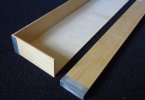Dog Star
Western Thunderer
Please note that this topic is concerned solely with those parts which form the sides and ends of the body - at the moment any wagon parts below the curb rail are outside the scope of this topic.
There are several S7 modellers whose era of interest can be loosely described as late Victorian / early Edwardian GWR... and there is one stand-out design of open wagon from that period, a four plank wagon for which construction started in the late Victorian period and continued into the early years of the Edwardian era. A drawing of this type of wagon can be found in GWR Wagons (pub. Tourret) and photos can be found in several other GWR wagon books ( J H Russell, pub. OPC)... there are several relevant drawings in the NRM GWR C&W catalogue so there is reasonable reference material.
Discussions amongst the group of modellers suggests that there is a common desire for an etched wagon underframe and appropriate work towards a set of etch parts is underway. Parts such as buffer stocks, bearing springs, coupling hooks (and springs) are likely to be 3D prints or lost wax castings.
The "elephant-in-the-room" is the wagon body - there are three suitable / appropriate / reasonable kits known to me, being:-
1/ WEP etch brass;
2/ Peco ex Webster polystyrene;
3/ Slaters ex Cooper-craft polystyrene.
The big question is this - "which kit ought to be considered as the starting point for the intended models and why?".
Not a trick question, maybe there is no "best" answer, just a case of seeing what others think about offerings as kits.
regards, Graham
There are several S7 modellers whose era of interest can be loosely described as late Victorian / early Edwardian GWR... and there is one stand-out design of open wagon from that period, a four plank wagon for which construction started in the late Victorian period and continued into the early years of the Edwardian era. A drawing of this type of wagon can be found in GWR Wagons (pub. Tourret) and photos can be found in several other GWR wagon books ( J H Russell, pub. OPC)... there are several relevant drawings in the NRM GWR C&W catalogue so there is reasonable reference material.
Discussions amongst the group of modellers suggests that there is a common desire for an etched wagon underframe and appropriate work towards a set of etch parts is underway. Parts such as buffer stocks, bearing springs, coupling hooks (and springs) are likely to be 3D prints or lost wax castings.
The "elephant-in-the-room" is the wagon body - there are three suitable / appropriate / reasonable kits known to me, being:-
1/ WEP etch brass;
2/ Peco ex Webster polystyrene;
3/ Slaters ex Cooper-craft polystyrene.
The big question is this - "which kit ought to be considered as the starting point for the intended models and why?".
Not a trick question, maybe there is no "best" answer, just a case of seeing what others think about offerings as kits.
regards, Graham


 are birch ply cut with a scalpel and beer can corner plates.
are birch ply cut with a scalpel and beer can corner plates.
